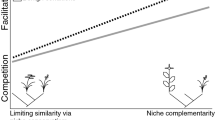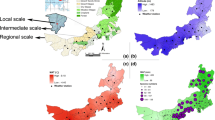Abstract
Positive and negative interactions can occur simultaneously between plant species. According to the stress gradient hypothesis (SGH), species interactions shift towards more facilitative interactions or reductions in competition with increasing stress, whereas debate continues over whether evolutionary history influences the strength of species interactions. However, few studies have investigated the effects of phylogenetic relatedness (i.e., the sum of branch lengths separating species on a phylogeny) on the outcomes of interspecific interactions across stress levels. Therefore, we conducted a Bayesian meta-analysis on data collected from publications on plant interactions within coastal ecosystems in order to investigate the effects of phylogenetic relatedness on interspecific interactions across different stress levels. These analyses showed the effect sizes of species interactions on survival and growth to increase with stress increment, supporting the SGH in coastal ecosystems. However, phylogenetic relatedness did not lead to these differences of interspecific interactions between low and high stress. We found that species interactions affecting plant survival were not significantly influenced by phylogenetic relatedness; however, when evolutionary relationships of target and neighbor species were more phylogenetically distant, their interactions were more likely to facilitate growth of target species. Furthermore, the effect of the interaction between phylogenetic distance and stress on species interactions was negative. This suggests the observed net effects of phylogenetically distant neighbor species on target species were not due to true facilitation but reductions in competition when moving from low stress to high stress environments. According to these results, phylogenetic relatedness should be considered in choosing species for restoration of coastal ecosystem plant communities. Specifically, increasing the phylogenetic breadth of the assemblage is more likely to include species that have evolved to reduce stress on surrounding species through modification of the environment.

Similar content being viewed by others
References
Bertness, M.D., and R. Callaway. 1994. Positive interactions in communities. Trends in Ecology & Evolution 9: 191–193.
Bertness, M.D., and S.D. Hacker. 1994. Physical stress and positive associations among marsh plants. American Naturalist 144: 363–372.
Borenstein, M., L. Hedges, J. Higgins, and H. Rothstein. 2009. Introduction to meta-analysis. Chichester, U.K.: John Wiley & Sons.
Bremer, B., K. Bremer, M.W. Chase, M.F. Fay, J.L. Reveal, D.E. Soltis, P.S. Soltis, P.F. Stevens, A.A. Anderberg, M.J. Moore, R.G. Olmstead, P.J. Rudall, K.J. Sytsma, D.C. Tank, K. Wurdack, J.Q.Y. Xiang, S. Zmarzty, and G. Angiosperm Phylogeny. 2009. An update of the Angiosperm Phylogeny Group classification for the orders and families of flowering plants: APG III. Botanical Journal of the Linnean Society 161: 105–121.
Bruno, J.F., J.J. Stachowicz, and M.D. Bertness. 2003. Inclusion of facilitation into ecological theory. Trends in Ecology & Evolution 18: 119–125.
Burns, J.H., and S.Y. Strauss. 2011. More closely related species are more ecologically similar in an experimental test. Proceedings of the National Academy of Sciences of the United States of America 108: 5302–5307.
Cahill, J.F., S.W. Kembel, E.G. Lamb, and P.A. Keddy. 2008. Does phylogenetic relatedness influence the strength of competition among vascular plants? Perspectives in Plant Ecology Evolution and Systematics 10: 41–50.
Callaway, R.M., and S.C. Pennings. 2000. Facilitation may buffer competitive effects: indirect and diffuse interactions among salt marsh plants. American Naturalist 156: 416–424.
Castillo, J.P., M. Verdu, and A. Valiente-Banuet. 2010. Neighborhood phylodiversity affects plant performance. Ecology 91: 3656–3663.
Crain, C.M., B.R. Silliman, S.L. Bertness, and M.D. Bertness. 2004. Physical and biotic drivers of plant distribution across estuarine salinity gradients. Ecology 85: 2539–2549.
Darwin, C. 1859. On the origin of species by means of natural selection. London: J. Murray.
Fritschie, K.J., B.J. Cardinale, M.A. Alexandrou, and T.H. Oakley. 2014. Evolutionary history and the strength of species interactions: testing the phylogenetic limiting similarity hypothesis. Ecology 95: 1407–1417.
Gedan, K.B., B.R. Silliman, and M.D. Bertness. 2009. Centuries of human-driven change in salt marsh ecosystems. Annual Review of Marine Science 1: 117–141.
Gomez-Aparicio, L. 2009. The role of plant interactions in the restoration of degraded ecosystems: a meta-analysis across life-forms and ecosystems. Journal of Ecology 97: 1202–1214.
Hadfield, J.D. 2010. MCMC methods for multi-response generalized linear mixed models: the MCMCglmm R Package. Journal of Statistical Software 33: 1–22.
Hadfield, J.D., and S. Nakagawa. 2010. General quantitative genetic methods for comparative biology: phylogenies, taxonomies and multi-trait models for continuous and categorical characters. Journal of Evolutionary Biology 23: 494–508.
Halpern, B.S., B.R. Silliman, J.D. Olden, J.P. Bruno, and M.D. Bertness. 2007. Incorporating positive interactions in aquatic restoration and conservation. Frontiers in Ecology and the Environment 5: 153–160.
He, Q., B.S. Cui, M.D. Bertness, and Y. An. 2012. Testing the importance of plant strategies on facilitation using congeners in a coastal community. Ecology 93: 2023–2029.
He, Q., M.D. Bertness, and A.H. Altieri. 2013. Global shifts towards positive species interactions with increasing environmental stress. Ecology Letters 16: 695–706.
Hedges, S.B., J. Dudley, and S. Kumar. 2006. TimeTree: a public knowledge-base of divergence times among organisms. Bioinformatics 22: 2971–2972.
Lortie, C.J., and R.M. Callaway. 2006. Re-analysis of meta-analysis: support for the stress-gradient hypothesis. Journal of Ecology 94: 7–16.
Maestre, F.T., F. Valladares, and J.F. Reynolds. 2005. Is the change of plant-plant interactions with abiotic stress predictable? A meta-analysis of field results in arid environments. Journal of Ecology 93: 748–757.
Maherali, H., and J.N. Klironomos. 2007. Influence of phylogeny on fungal community assembly and ecosystem functioning. Science 316: 1746–1748.
Mayfield, M.M., and J.M. Levine. 2010. Opposing effects of competitive exclusion on the phylogenetic structure of communities. Ecology Letters 13: 1085–1093.
Silliman, B.R., E. Schrack, Q. He, R. Cope, A. Santoni, T. van der Heide, R. Jacobi, M. Jacobi, and J. van de Koppel. 2015. Facilitation shifts paradigms and can amplify coastal restoration efforts. Proceedings of the National Academy of Sciences of the United States of America 112: 14295–14300.
Soliveres, S., R. Torices, and F.T. Maestre. 2012. Evolutionary relationships can be more important than abiotic conditions in predicting the outcome of plant-plant interactions. Oikos 121: 1638–1648.
Valiente-Banuet, A., A.V. Rumebe, M. Verdu, and R.M. Callaway. 2006. Modern quaternary plant lineages promote diversity through facilitation of ancient tertiary lineages. Proceedings of the National Academy of Sciences of the United States of America 103: 16812–16817.
Verdu, M., P.J. Rey, J.M. Alcantara, G. Siles, and A. Valiente-Banuet. 2009. Phylogenetic signatures of facilitation and competition in successional communities. Journal of Ecology 97: 1171–1180.
Verdu, M., L. Gomez-Aparicio, and A. Valiente-Banuet. 2012. Phylogenetic relatedness as a tool in restoration ecology: a meta-analysis. Proceedings of the Royal Society B-Biological Sciences 279: 1761–1767.
Violle, C., D.R. Nemergut, Z.C. Pu, and L. Jiang. 2011. Phylogenetic limiting similarity and competitive exclusion. Ecology Letters 14: 782–787.
Webb, C.O. 2000. Exploring the phylogenetic structure of ecological communities: an example for rain forest trees. American Naturalist 156: 145–155.
Webb, C.O., and M.J. Donoghue. 2005. Phylomatic: tree assembly for applied phylogenetics. Molecular Ecology Notes 5: 181–183.
Webb, C.O., D.D. Ackerly, and S.W. Kembel. 2008. Phylocom: software for the analysis of phylogenetic community structure and trait evolution. Bioinformatics 24: 2098–2100.
Wikstrom, N., V. Savolainen, and M.W. Chase. 2001. Evolution of the angiosperms: calibrating the family tree. Proceedings of the Royal Society B-Biological Sciences 268: 2211–2220.
Zhang, L.W., and H.B. Shao. 2013. Direct plant-plant facilitation in coastal wetlands: a review. Estuarine, Coastal and Shelf Science 119: 1–6.
Acknowledgments
We are grateful to Dr. He Qiang who provided us with a part of the data published in Ecology Letters, and we also appreciated the authors for generously sharing data sets in this meta-analysis. We thank the reviewers and editor for their comments and suggestions, which have been very helpful for improving the manuscript. We would also like to thank Christine Verhille at the University of British Columbia for her assistance with English language and grammatical editing of the manuscript. This research is funded by the National Natural Science Foundation of China (No. 31100313), the Foundation for Outstanding Young Scientist in Shandong Province (No. BS2013HZ012), and the Program of Science and Technology Service Network Initiative, Chinese Academy of Sciences (No. KFJ-EW-STS-127).
Author information
Authors and Affiliations
Corresponding author
Additional information
Communicated by Iris C. Anderson
Electronic Supplementary Material
Below is the link to the electronic supplementary material.
ESM 1
(DOCX 428 kb)
Rights and permissions
About this article
Cite this article
Zhang, L., Mi, X. & Shao, H. Phylogenetic Relatedness Influences Plant Interspecific Interactions Across Stress Levels in Coastal Ecosystems: a Meta-Analysis. Estuaries and Coasts 39, 1669–1678 (2016). https://doi.org/10.1007/s12237-016-0104-2
Received:
Revised:
Accepted:
Published:
Issue Date:
DOI: https://doi.org/10.1007/s12237-016-0104-2




